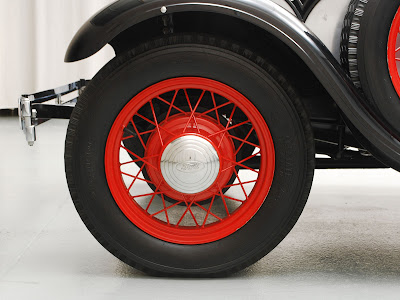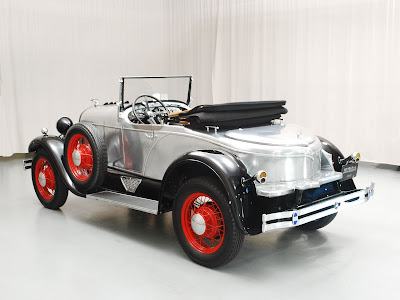 It was relatively simple even in the days of Henry Ford's Model
T and Model A to load up a roadster with speed parts and accessories
but true craftsmen took creation of their personal rides many steps
farther.
It was relatively simple even in the days of Henry Ford's Model
T and Model A to load up a roadster with speed parts and accessories
but true craftsmen took creation of their personal rides many steps
farther.One of them was E.J. Walton who created this one-of-a-kind Model A. Walton is believed to have been one of the principal fabricators and body builders for Harry Miller, reportedly the fabricator behind the Miller-Fords and Gulf-Millers. This 1929 Ford Model A Roadster is believed to have been built as his personal car. While its engine is modestly hot rodded with a copper plated cylinder head, fabricated copper intake manifold, Stromberg downdraft carb, custom exhaust and Mallory dual point distributor. But it is the custom coachwork that sets this Ford apart from all but the highest concept custom roadsters. The complete body -- hood, passenger compartment and custom boattail rear deck -- is hand hammered out of aluminum, then left unpainted in an object demonstration of superb panel beating and joining skills.
The radiator is contained within a hand made vee-front rounded shell painted black. The hood sides are separated by a fixed center panel with four stack-like projections, also in black to complement the radiator shell. The hood sides have diamond-shaped embellishments in black which are repeated in slightly different proportions on the frame covers under the doors. The breathing areas of the bodywork - grille, hood sides and the decorative elements under the doors - are covered with basket weave metal mesh. Black fenders, frame covers and running boards set off the aluminum body. The rear deck of the body is gently rounded in a semi-boattail shape with an opening lid for luggage and tools. Red wire wheels, including a pair of sidemounted spares, provide a touch of color. It is upholstered in black leather with a black cloth top and has been carefully maintained with attention to cosmetics like the paint on the fenders and the upholstery. In addition to its oral history connection with E.J. Watson its origins are supported by its present chain of title which begins in Asheville, NC where Walton settled after his racing days were over. A meticulously constructed example of the talent and creativity of an old-school fabricator, sympathetically preserved for years, this 1929 Ford Model A Custom roadster is a piece of American automobile history with style, performance and delightful patina.
$76,500.00
Stock Number: 4715
Stock Number: 4715
Please visit the Purchasing Info
section if you are interested in a car or call us at
314-524-6000 for immediate assistance.
314-524-6000 for immediate assistance.


















